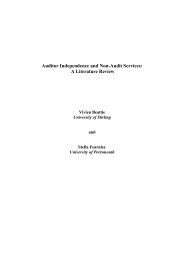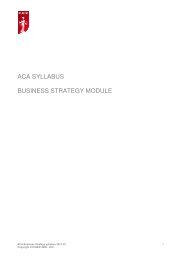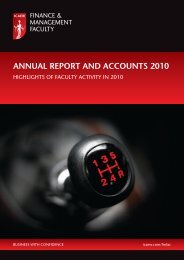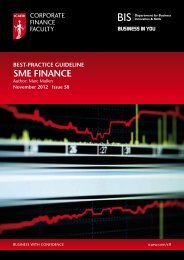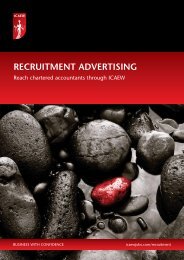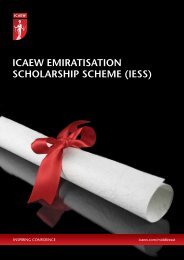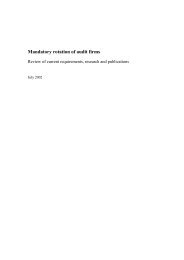In short: ‘carrot, stick or sermon’? 222An <strong>in</strong>fluence will be <strong>the</strong> extent to which behaviour that is beyond accepted values is, <strong>in</strong> <strong>the</strong>circumstances under consideration, tolerable, and/or whe<strong>the</strong>r en<strong>for</strong>cement is needed?Panel 9.1: Traffic lightsAn example from <strong>the</strong> Ne<strong>the</strong>rlands re<strong>in</strong><strong>for</strong>ces <strong>the</strong> potential impact of consider<strong>in</strong>g alternativesto carrot or stick. There, and latterly <strong>in</strong> a number of o<strong>the</strong>r countries, <strong>the</strong>re have beenexperiments with controll<strong>in</strong>g traffic <strong>in</strong> urban areas by remov<strong>in</strong>g, ra<strong>the</strong>r than <strong>in</strong>creas<strong>in</strong>g,traffic lights, barriers and signs. In Section 7.1.1 an example was noted of chaos <strong>in</strong> Manhattanwhen power loss switched off traffic signals. This, presumably, was at least partly becausepeople were used to be<strong>in</strong>g told exactly what to do at <strong>in</strong>tersections and had ceased to have toth<strong>in</strong>k about <strong>in</strong>teract<strong>in</strong>g with o<strong>the</strong>rs. The Dutch and o<strong>the</strong>r experiments work on <strong>the</strong> premisethat by remov<strong>in</strong>g <strong>the</strong> detailed controls and mak<strong>in</strong>g cars and pedestrians <strong>in</strong>teract <strong>in</strong> a lessspecified manner: <strong>in</strong> short replac<strong>in</strong>g clarity and segregation with confusion and ambiguity,people will become more cautious and accommodat<strong>in</strong>g. The traffic world is replaced with asocial world, appeal<strong>in</strong>g to people’s <strong>in</strong>tr<strong>in</strong>sic social norms. While <strong>the</strong> traffic planners concedethis would not work everywhere, results have been encourag<strong>in</strong>g: traffic has cont<strong>in</strong>ued toflow but accidents have reduced. 223What is needed, <strong>the</strong>re<strong>for</strong>e, is a comb<strong>in</strong>ation of ‘carrot, stick and sermon’, which mighto<strong>the</strong>rwise be referred to as <strong>in</strong>centives <strong>for</strong> compliance, requirements <strong>for</strong> compliance, and<strong>in</strong><strong>for</strong>mation that persuades compliance.Panel 9.2: <strong>ICAEW</strong> approach to implementationThe approach used <strong>in</strong> practice by <strong>ICAEW</strong> illustrates <strong>the</strong> application of a comb<strong>in</strong>ation ofapproaches. The <strong>ICAEW</strong> code of ethics, <strong>in</strong> common with that of IESBA, generally applies apr<strong>in</strong>ciples based approach whereby <strong>the</strong> fundamental pr<strong>in</strong>ciples of behaviour (ie, social norms)with<strong>in</strong> <strong>the</strong> profession are set out and <strong>the</strong>n, with<strong>in</strong> a <strong>framework</strong>, <strong>the</strong> professionals <strong>the</strong>mselvesare left to determ<strong>in</strong>e potential threats to compliance with <strong>the</strong> pr<strong>in</strong>ciples and what safeguardscan be applied to address <strong>the</strong>se. The element of self-assessment <strong>in</strong>herent <strong>in</strong> such an approachdoes work on <strong>the</strong> basis of how people ought to behave, ra<strong>the</strong>r than how some do, althoughthreats to compliance through conflicts such as self-<strong>in</strong>terest, are recognised explicitly as anissue that needs to be addressed.However, <strong>the</strong>re are a number of absolute requirements and prohibitions and <strong>the</strong>se areen<strong>for</strong>ced through monitor<strong>in</strong>g and discipl<strong>in</strong>ary regimes, which recognise that some peopledo not always behave as <strong>the</strong>y ought to.Thus advantage is taken of <strong>the</strong> professional <strong>in</strong>frastructure to apply a comb<strong>in</strong>ation of ‘sermon’and targeted ‘stick’.We also discuss comb<strong>in</strong>ations of <strong>the</strong>se approaches <strong>in</strong> our thought leadership work, <strong>for</strong>example, taxes, subsidies and tradable permits and/or requirements and prohibitions <strong>in</strong> <strong>the</strong>context of implement<strong>in</strong>g susta<strong>in</strong>ability targets. 2249.2 Sufficiency of authority and remitIf a case has been made <strong>for</strong> <strong>in</strong>tervention <strong>in</strong> people’s affairs ‘<strong>in</strong> <strong>the</strong> <strong>public</strong> <strong>in</strong>terest’, that meansthat somebody must do <strong>the</strong> <strong>in</strong>terven<strong>in</strong>g (Hobbes’ ‘leviathan’ 225 ) and those who are <strong>the</strong> subjectof <strong>the</strong> <strong>in</strong>tervention must accept <strong>the</strong> authority to do so.As well as <strong>the</strong> means of implementation considered above, <strong>the</strong> regulator or o<strong>the</strong>r implementerneeds to consider whe<strong>the</strong>r what it believes <strong>the</strong> appropriate <strong>public</strong> <strong>in</strong>terest action is, fits withits accepted remit and/or authority. This might be too narrow or misaligned with what <strong>the</strong>regulator, hav<strong>in</strong>g taken all matters <strong>in</strong>to account, believes would be <strong>the</strong> right th<strong>in</strong>g to do.In those circumstances, a course of action might be along <strong>the</strong> l<strong>in</strong>es of: ‘let’s do what wecan with<strong>in</strong> our remit’, which will, assum<strong>in</strong>g <strong>the</strong>ir <strong>in</strong>itial <strong>analysis</strong> is right, be sub-optimal bydef<strong>in</strong>ition. An alternative course of action, <strong>in</strong> <strong>the</strong> <strong>in</strong>terests of transparency and, ultimately, <strong>the</strong>‘best’ solution, might be to <strong>public</strong>ise <strong>the</strong> issue <strong>in</strong> <strong>the</strong> <strong>in</strong>terests of a debate on whe<strong>the</strong>r <strong>the</strong> remitand/or authority should be amended, or <strong>the</strong> objective allocated elsewhere. That is, <strong>the</strong>re maybe elements of justification and persuasion.222Peter-Burth and Gotitz, ‘Review of “Carrots Sticks & Sermons”’, Rothschild, ‘Carrots, Sticks and Promises: A ConceptualFramework <strong>for</strong> <strong>the</strong> Management of Public Health and Social Issue Behaviours’.223Vanderbilt, ‘The Traffic Guru’.224<strong>ICAEW</strong>, Susta<strong>in</strong>ability: The Role of Accountants.225Quoted <strong>in</strong> Faulhaber, ‘The Rise and Fall of ‘Self Interest’’.64Implementation
9.2.1 Government authorityAt <strong>the</strong> state level <strong>the</strong> ultimate authority will take <strong>the</strong> <strong>for</strong>m of, or derive from, government,although this need not always be so. There are examples of groups <strong>in</strong> Africa exist<strong>in</strong>g withoutwhat would nowadays be regarded as government well <strong>in</strong>to <strong>the</strong> twentieth century. 226 Thereis also no authoritative <strong>in</strong>ternational government, which means that adopt<strong>in</strong>g <strong>the</strong> ‘sermon’approach is often <strong>the</strong> only proportional approach, though often slow <strong>in</strong> terms of effect. The‘stick’ approach <strong>in</strong> particular, can be extreme <strong>in</strong> an <strong>in</strong>ternational context, and raises issues ofjustification of proportionality aga<strong>in</strong>st norms which may differ from one country to ano<strong>the</strong>r.Panel 9.3: Existence of governmentTwo general explanations <strong>for</strong> <strong>the</strong> existence of government are advanced: social contract <strong>the</strong>ory,<strong>in</strong> which <strong>the</strong> cost of organisation, en<strong>for</strong>cement, and ma<strong>in</strong>tenance of <strong>public</strong> goods is outweighedby <strong>the</strong> economic benefits from <strong>in</strong>creased trade; and predatory <strong>the</strong>ory, <strong>in</strong> which <strong>for</strong>ce is usedto secure advantage <strong>for</strong> those exercis<strong>in</strong>g it. 227 From a <strong>public</strong> <strong>in</strong>terest perspective, <strong>the</strong> predatory<strong>the</strong>ory is, while perhaps a fact <strong>in</strong> some places, hardly a justification and social contract <strong>the</strong>oryhas more place as a reasonable means of consider<strong>in</strong>g <strong>in</strong>tervention <strong>in</strong> <strong>the</strong> <strong>public</strong> <strong>in</strong>terest.It follows from social contract <strong>the</strong>ory that governments, and o<strong>the</strong>r organisations set up tobenefit <strong>the</strong> <strong>public</strong>, will not be worthwhile where:• <strong>the</strong> cost would be excessive, as might be <strong>the</strong> case with an <strong>in</strong>ternational government;• <strong>the</strong> benefits would be few – <strong>for</strong> example <strong>in</strong> a primitive society where <strong>the</strong> small populationand low level of diversity <strong>in</strong> skills and preferences would result <strong>in</strong> a limited <strong>in</strong>crease <strong>in</strong>ga<strong>in</strong>s from trade. 228All governments nowadays claim authority over <strong>the</strong>ir subjects to a greater or lesser degree. 229A couple of examples <strong>in</strong>clude:• <strong>the</strong> UK Crown Proceed<strong>in</strong>gs Act 1947, which states that where <strong>the</strong> executive governmenttakes advantage of a statute it is deemed to be <strong>for</strong> <strong>the</strong> <strong>public</strong> benefit.• A comment by Harold Wilson MP (later UK Prime M<strong>in</strong>ister) <strong>in</strong> <strong>the</strong> UK parliament: ‘…In <strong>the</strong>last resort, this House is, and must be, <strong>the</strong> authority which decides whe<strong>the</strong>r or not anyparticular practice is <strong>in</strong> <strong>the</strong> <strong>public</strong> <strong>in</strong>terest.’ 230There<strong>for</strong>e, at least <strong>in</strong> <strong>the</strong> UK, <strong>the</strong> government af<strong>for</strong>ds itself democratic legitimacy and deems<strong>the</strong> determ<strong>in</strong>ations it makes to be <strong>in</strong> <strong>the</strong> <strong>public</strong> <strong>in</strong>terest. This accords with <strong>the</strong> def<strong>in</strong>ition quotedearlier from a UK judge (Section 5.3) which sees <strong>the</strong> government as arbitrator.There are limits to <strong>the</strong> authority of <strong>the</strong> state. These vary from country to country, at least partlybased on <strong>the</strong> cultural issues referred to previously, as do <strong>the</strong> means of en<strong>for</strong>c<strong>in</strong>g those limits. Inmany market economies, <strong>the</strong> default position would appear to be what John Stuart Mill called<strong>the</strong> ‘liberty pr<strong>in</strong>ciple’: ‘<strong>the</strong> only purpose <strong>for</strong> which power can be rightfully exercised over anymember of a civilised community, aga<strong>in</strong>st his will, is to prevent harm to o<strong>the</strong>rs.’ 231 However, thisis not always spelt out.Even <strong>in</strong> that situation, governments will sometimes consider that o<strong>the</strong>rs are more suited toexercis<strong>in</strong>g that power: <strong>the</strong> cont<strong>in</strong>ued survival of professional bodies be<strong>in</strong>g an illustration of this.Even <strong>the</strong> liberty pr<strong>in</strong>ciple leaves wide room <strong>for</strong> <strong>in</strong>terpretation and mechanisms have evolved toconstra<strong>in</strong>, or impel, executive government action. Sometimes <strong>the</strong>se <strong>in</strong>volve <strong>in</strong>dividual or collectiveactivism apply<strong>in</strong>g what has been called: ‘<strong>the</strong> time-tested tools of <strong>in</strong>vestigative research, mediaexposés, grassroots organis<strong>in</strong>g, advocacy and litigation.’ 232 Public <strong>in</strong>terest litigation has evolved<strong>in</strong> many countries. In India, <strong>for</strong> example, one of <strong>the</strong> drivers beh<strong>in</strong>d such litigation has beendescribed as <strong>the</strong> redress<strong>in</strong>g of grievances aga<strong>in</strong>st bureaucratic unresponsiveness. 233 In <strong>the</strong> UKthis falls with<strong>in</strong> <strong>the</strong> process of ‘judicial review’, which aga<strong>in</strong> exists to keep <strong>the</strong> executive actionof <strong>the</strong> government with<strong>in</strong> <strong>the</strong> bounds of what <strong>the</strong> legislature has determ<strong>in</strong>ed to be <strong>in</strong> <strong>the</strong><strong>public</strong> <strong>in</strong>terest. 234 This does not, <strong>in</strong> <strong>the</strong> UK, extend to create <strong>public</strong> policy from scratch: <strong>the</strong> UKSupreme Court notes that it: ’does not have <strong>the</strong> power to strike down legislation passed by <strong>the</strong>UK parliament. It is not <strong>the</strong> court’s role to <strong>for</strong>mulate <strong>public</strong> policy, but to <strong>in</strong>terpret law.’ 235226Leeson, ‘Efficient anarchy’.227From Leeson, ibid.228Leeson, ibid.229Miller, Political Philosophy.230Hansard.231Mill, Utilitarianism. Mill used <strong>the</strong> word ‘harm’ <strong>in</strong> a narrow fashion, imply<strong>in</strong>g direct harm only.232US Public Interest Research Group, ‘Mission Statement’.233S<strong>in</strong>ha, ‘Public Interest Litigation’.234Ibid.235UK Supreme Court , ‘Frequently Asked Questions’.Implementation65
- Page 1 and 2:
ACTING IN THE PUBLIC INTEREST:A FRA
- Page 3:
ACTING IN THE PUBLIC INTEREST:A FRA
- Page 9:
Our framework is based around the k
- Page 12 and 13:
The answers to these questions will
- Page 14 and 15:
2. INTRODUCTION2.1 Concepts of the
- Page 16 and 17:
Accordingly, this report addresses
- Page 18 and 19: Panel 2.4: ICAEW and its public int
- Page 20 and 21: The Mediterranean republics needed
- Page 22 and 23: We set out a framework for discussi
- Page 24 and 25: 3. CREDENTIALS FOR INVOKINGTHE PUBL
- Page 26 and 27: By and large producers operate in s
- Page 29 and 30: the UK government set up a ‘Commi
- Page 31 and 32: 4. APPLICABILITY OF THE PUBLIC INTE
- Page 33 and 34: to be a public interest matter: fir
- Page 35: This highlights that there may be p
- Page 38 and 39: 5. THE RELEVANT PUBLIC5.1 ScopeIn o
- Page 40 and 41: 5.3 Geographical exclusionsGeograph
- Page 42 and 43: 6. THE RELEVANT PUBLIC’S WANTS6.1
- Page 44 and 45: • work, that is having some, havi
- Page 46 and 47: Panel 6.3: Weisbrod’s public inte
- Page 48 and 49: Having sought out representative op
- Page 50 and 51: 7. CONSTRAINTS TO WANTS7.1 Self-int
- Page 52 and 53: In terms of whether the relevant pu
- Page 54 and 55: Panel 7.5: Management of national d
- Page 56 and 57: Panel 7.6: ICAEW and clarity of val
- Page 58 and 59: 8. AGGREGATION AND DECISION8.1 Base
- Page 60 and 61: Other ethical decision-making model
- Page 62 and 63: In this instance, while national se
- Page 65 and 66: 9. IMPLEMENTATIONA proposed action
- Page 67: • giving up where targets seem un
- Page 71 and 72: 9.3 Infrastructure and support tool
- Page 73 and 74: 12. The framework proposes a signif
- Page 75 and 76: ibliographyAdler, Jonathan H, Perve
- Page 77 and 78: Goldstein, Eric A, ‘Defining the
- Page 79 and 80: Persky, Joseph, ‘Retrospectives:
- Page 81: The ICAEW is a founder member of th



